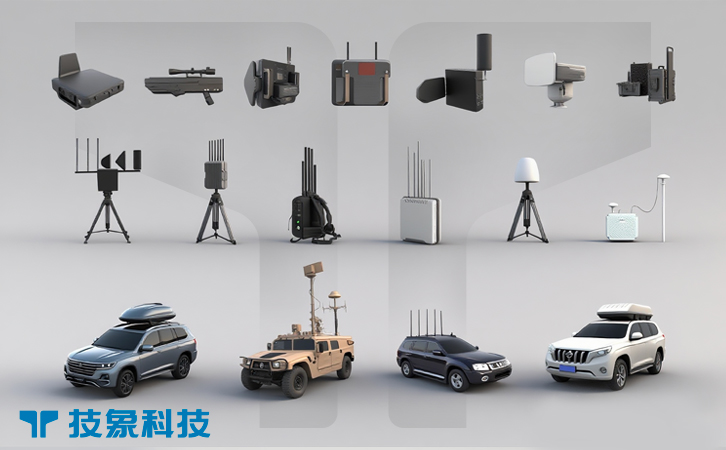The exponential growth of unmanned aerial vehicles (UAVs), with over 6 million commercial drones in operation worldwide in 2025, has heightened security risks from rogue drones involved in smuggling, surveillance, or attacks on critical infrastructure. Counter-drone systems (C-UAS) are essential to mitigate these threats, and high-energy lasers (HELs) represent a cutting-edge solution, using concentrated light beams to disable drones by overheating electronics or melting structures. As a non-kinetic weapon, HELs offer speed-of-light engagement with low per-shot costs, making them ideal for countering swarms where traditional missiles are inefficient. From military bases to urban events, HELs are reshaping defenses. This article delves into the principles of high-energy lasers, their applications in counter-drone operations, integration with other systems, and the challenges and future developments, illustrating their transformative impact on aerial security.
I. The Principles of High-Energy Lasers in Counter-Drone Operations
High-energy lasers operate by focusing a coherent beam of light, typically in the infrared spectrum (1-2 micrometers), onto a drone to deliver intense thermal energy, causing structural failure or electronic disruption. In 2025, HEL systems like the U.S. Navy’s LaWS generate beams with power outputs of 50-400 kW, sufficient to burn through a drone’s airframe in seconds at ranges up to 5 km. The process involves a laser source (fiber or solid-state), beam director (gimbal for targeting), and power supply (generators or batteries), with adaptive optics correcting for atmospheric distortion like turbulence or humidity.
When engaged, the laser beam travels at light speed (300,000 km/s), instantly heating the drone’s surface to over 1,000°C, melting propellers, igniting batteries, or blinding sensors. Unlike kinetic weapons, HELs have unlimited “ammunition” as long as power is supplied, with per-engagement costs under $1, compared to $2 million for missiles. A 2025 U.S. Army test demonstrated a 50 kW HEL downing five drones in 90 seconds, highlighting efficiency against swarms. HELs are non-kinetic, reducing debris risks in urban areas, but effectiveness depends on dwell time—the duration the beam must remain on target—and weather, as rain scatters the beam. These principles make HELs a game-changer for counter-drone operations, providing rapid, cost-effective defense in diverse environments from battlefields to airports.
II. Applications in Countering Rogue Drones
High-energy lasers have diverse applications in countering rogue drones, from military to civilian scenarios, due to their precision and scalability. In military operations, HELs protect forward bases and convoys, as seen in 2025 Ukraine deployments where a 100 kW system neutralized reconnaissance drones without resupply needs. The U.S. Navy’s HELIOS, integrated on Arleigh Burke destroyers, counters Houthi drone swarms in the Red Sea, engaging multiple threats sequentially at light speed, preserving missile stocks for higher-value targets.
Civilian applications focus on safeguarding infrastructure. Airports, plagued by over 400 drone incursions in the U.S. in early 2025, use HELs like Boeing’s Compact Laser Weapon System to disable unauthorized UAVs without endangering aircraft. A 2025 trial at Dubai International Airport demonstrated HELs safely redirecting smuggling drones, minimizing flight delays. Prisons adopt HELs to prevent contraband drops, with a California facility in 2025 using a 50 kW system to overheat drone electronics mid-flight, reducing smuggling incidents by 60%. Urban events, like stadiums, benefit from vehicle-mounted HELs that neutralize surveillance drones without crowd risks.
HELs excel against swarms, rapidly retargeting to thin out groups, as tested in a 2025 U.S. Marine Corps exercise downing 20 drones in minutes. Their non-lethal mode—blinding sensors—offers de-escalation options, making HELs versatile for both kinetic and electronic warfare in countering rogue drones across global hotspots.
III. Integration with Other Counter-Drone Systems
High-energy lasers are most effective when integrated with complementary C-UAS technologies, forming layered defenses that detect, track, and neutralize threats seamlessly. Integration begins with sensors: radar and RF systems identify drones, providing coordinates to the laser’s beam director for precise targeting. For example, Lockheed Martin’s MORFIUS, deployed in 2025, pairs HELs with radar for swarm defense, using AI to prioritize targets and automate engagement, reducing operator workload.
EO/IR cameras complement HELs by confirming targets visually, ensuring no misfires on benign objects like birds, a common false positive in radar. In a 2025 naval trial, the U.S. Navy’s SONGBOW 400 kW laser integrated with EO/IR sensors engaged drones in foggy conditions, achieving 98% accuracy. Command-and-control platforms, like Northrop Grumman’s AiON, fuse data from sensors to cue HELs, enabling rapid responses—under 5 seconds from detection to neutralization.
Vehicle or ship-mounted HELs, such as the Army’s DE M-SHORAD on Strykers, integrate with mobile platforms for dynamic operations, while fixed installations at airports use HELs alongside jamming for redundancy. Challenges include power sharing, as HELs demand kilowatts, requiring efficient generators, and software interoperability to avoid data silos. The 2025 Counter UAS Technology USA Conference emphasized open architectures for seamless integration, ensuring HELs function as a high-precision layer in comprehensive C-UAS ecosystems.
IV. Challenges and Future Innovations
High-energy lasers face notable challenges in counter-drone applications. Atmospheric interference, like rain or dust, scatters beams, reducing effective range by 50% in adverse weather, necessitating higher power or adaptive optics that increase costs—systems can exceed $10 million. Power demands (100-400 kW) require robust generators, limiting mobility for dismounted operations, as noted in 2025 U.S. Army reports. Targeting fast-moving or hardened drones, with reflective coatings or evasive AI, requires longer dwell times, complicating swarm defense.
Regulatory and ethical hurdles persist: international laws ban anti-personnel lasers, but anti-drone use raises concerns over unintended human harm, like eye injuries, prompting 2025 calls for safety protocols. Privacy issues arise from integrated surveillance, and environmental impacts from energy consumption warrant scrutiny. Future innovations address these: by 2030, quantum-enhanced beam control will improve atmospheric penetration by 40%, while fiber lasers reduce size and power needs by 30%. AI-driven targeting, tested in 2025 EU trials, will shorten dwell times, and hybrid systems combining HELs with microwaves will counter hardened drones. Global standards, proposed at the 2025 Maritime Counter UAS Conference, aim to harmonize regulations. These advancements will make HELs more reliable and accessible, solidifying their role in counter-drone defense.
Conclusion
High-energy lasers are revolutionizing counter-drone defense in 2025, burning through rogue UAV threats with precision and efficiency across military and civilian applications. Their speed-of-light engagement and low costs address the challenges of swarms and autonomous drones, integrated with sensors for layered protection. Despite hurdles like weather limitations and power demands, innovations in quantum tech and AI promise to overcome them. By investing in HELs and fostering ethical policies, stakeholders can enhance aerial security, countering evolving threats effectively. As drone proliferation continues, HELs will stand as a vital pillar in safeguarding airspaces from intrusion.



